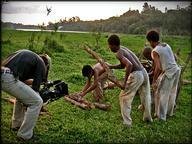Quiz Answer Key and Fun Facts
1. What 1858 rescue occurred in northern Ohio, near a well-known college that for the time so shockingly enrolled black students along with whites? The college was nowhere near the capital of Germany, but no one got confused, and both races worked together to make sure the rescue turned out WELL.
2. In the 1858 Ohio slave rescue, citizens came from the local college town to take the escaped slave to Canada so he wouldn't be returned to slavery in Mayfield, Kentucky. What was his name? He had a price on his head.
3. A slave named William Henry escaped from Missouri and was recaptured in Syracuse, N.Y., in 1851. A crowd gathered, broke him free from the courtroom and smuggled him to Canada. What was the rescue called? It is generally named using Henry's free name that he used in Syracuse, but this wasn't a rescue "about nothing" nor did he play the guitar like Mr. Garcia or the piano like Mr. Lee Lewis.
4. When a federal marshal attempted to recapture escaped slave William Henry, or Jerry, Oct. 1, 1851 in Syracuse, New York, what else was going on in Syracuse at that time? If one wanted to arrest a slave unmolested by abolitionists, it was probably the worst possible time and place to choose.
5. In 1835, a Tennessee slave owner recaptured a family named Stanford, who had made their escape to Canada. He ignored the niceties of international law and had his men just put the family on a ferry back to what city in New York? They might have wished for wings, but there were none in the city then.
6. The Stanford family were rescued in 1835 by dozens of New York Staters, including one who would go on to be a fairly famous writer and lecturer on anti-slavery topics. What was his name? He had the WILL to succeed and was WELL-known for writing, but even that couldn't save him from the prejudice his BROWN skin caused.
7. In 1854 Boston, what young man sparked major rioting and protests when slave catchers tried to return him to Virginia? His return ignited a fiery powderkeg of anger burning among citizens.
8. The Anthony Burns rescue in 1854 resulted in Burns being transported from Boston back to slavery in Virginia. What was the final outcome of his life? He was worth around $1,000 as a slave, and abolitionists were willing to donate to help the cause.
9. What escaped slave lived in Christiana, Pa. circa 1850, where he farmed and also organized aggressive anti-slavery activities? He had been enslaved in Maryland, but when he got free, he PARKed himself in Pennsylvania, stayed and built up connections with local abolitionists and underground railroad operators.
10. In 1851, Edward Gorsuch, a Maryland slave owner, arrived at William Parker's farm in Christiana, Lancaster County, Pa., with a marshal, helpers and all the paperwork to recapture slaves Parker was harboring. Parker and his men fought back, and in the end, Parker won, the slaves stayed free, and Gorsuch wound up dead. Parker fled to Canada with the assistance of what very famous black abolitionist in Rochester, NY?
Source: Author
littlepup
This quiz was reviewed by FunTrivia editor
bloomsby before going online.
Any errors found in FunTrivia content are routinely corrected through our feedback system.

